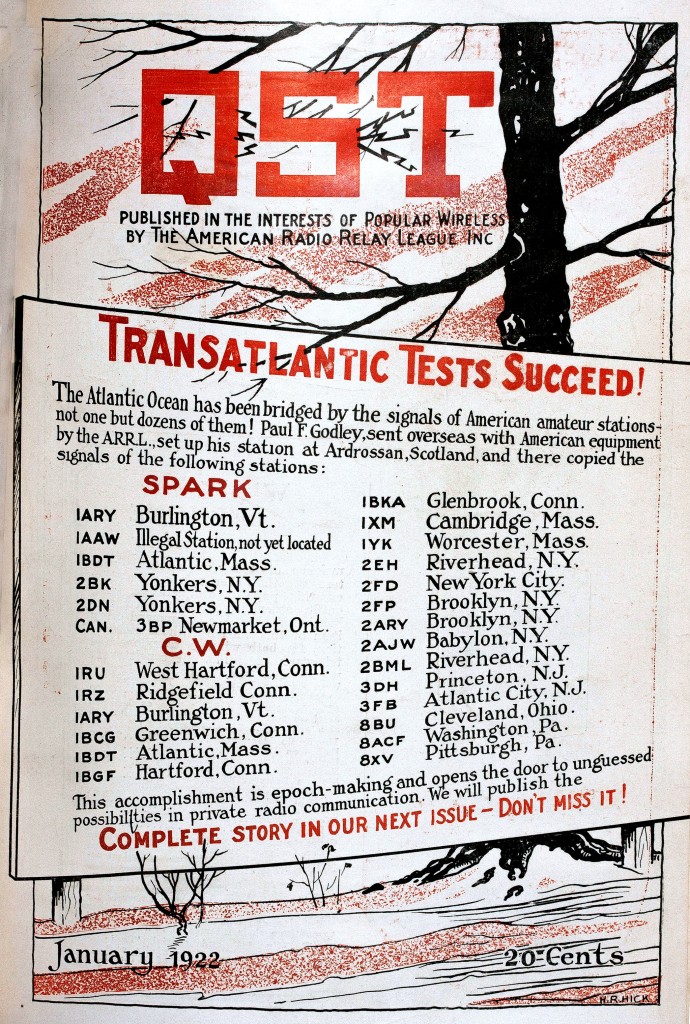 Back in London, Coursey1 kidded Paul Godley about freezing up north in soggy Scotland while he and the other British hams relaxed comfortably in their warm, cozy London homes, receiving signals using small aerials. British amateurs had indeed heard many northeast US stations, and 1BCG was also heard in Holland and on a ship docked at Hamburg. Godley spent ten hours at Coursey’s office documenting details of the test.
Back in London, Coursey1 kidded Paul Godley about freezing up north in soggy Scotland while he and the other British hams relaxed comfortably in their warm, cozy London homes, receiving signals using small aerials. British amateurs had indeed heard many northeast US stations, and 1BCG was also heard in Holland and on a ship docked at Hamburg. Godley spent ten hours at Coursey’s office documenting details of the test.
January QST’s banner cover headline read: Transatlantic Tests Succeed! – followed by a list of twenty CW and six spark stations whose signals had made it across during Godley’s adventures in Ardrossan. Inside, the lead article did not yet have all the details but proclaimed, “Transatlantic Tests Successful” and “WE GOT ACROSS!!!!!!”
“Excelsior!” crowed ARRL secretary Warner in his editorial as he recounted the skepticism with which an attempt at amateur transatlantic communications was met by professional communications engineers, and how certain they had been that amateurs could not possibly succeed.2 The feat rocked the radio community.
Warner continued:
They had no idea it could be done – strong and steady signals night after night at a distance of three thousand miles, with an input of less than a kilowatt and the wave length two hundred meters! They’re wondering today why they put in 200-kilowatt machines and miles of 500-foot towers and use wave lengths of many thousands of meters when a private citizen in his home in Podunk, Penn., with less than 50 watts of C.W. power can do the same thing.
He struck a nerve. In response, Bowden Washington, chief engineer at Independent Wireless Telegraph Co., took exception in a letter to QST. The commercial engineers, he said, were wondering no such thing and had taken aim at a different goal entirely. They spent more for higher power and big antennas to achieve reliable around-the-clock service.3
However, many still suspected the original 200 meter assignment was meant to do away with amateurs. Now that they had shown what could be done, the worry might shift to others coveting what was once considered “worthless.”
The identity of one of the successful transmitting stations continued to puzzle everyone. Exactly who 1AAW was—heard on spark that first night, identified on the January cover only as “Illegal Station, not yet located”—remained a mystery. Some had reported hearing the call sign locally in the Boston area, though the Roxbury, Massachusetts ham who actually held the call hadn’t been on the air in over six months.

In a long article The New York Times reported the entire story of the test including the planning, procedures, and participation, and wrongly credited the actual owner of 1AAW with the first signal received.4 “A new era in the history of amateur wireless work will date from this achievement,” the paper noted, emphasizing that low-powered instruments had surprisingly done the work of large, high powered commercial stations, probably annoying Mr. Washington and his colleagues yet again.
A second, smaller article in the same edition quoted Maxim who remarked, “It had not been thought possible by experts that amateurs could span the ocean, and we have proved that it could be done,” adding that, “The amateur’s apparatus has been developed on the basis of love for his work; it is not the perfunctory, although skillful, performance of the hired employee.” The article’s headline, “Maxim is Pleased with Radio Tests” indicates that he was well enough known to deserve a single-name reference in the Times.5
Paul Godley’s successful operation was a kind of combined contest and DXpedition. It took place outdoors in December during downpours, winds, and cold temperatures, operating on batteries from a tent heated by an oil stove and lit by an oil lantern. Winds and rain from a passing cyclone thrashed the location. “What a debt we owe Godley for what he went thru for us!” wrote Warner.6
If there were still any doubts about the effectiveness of CW over spark, the transatlantics swept them aside.

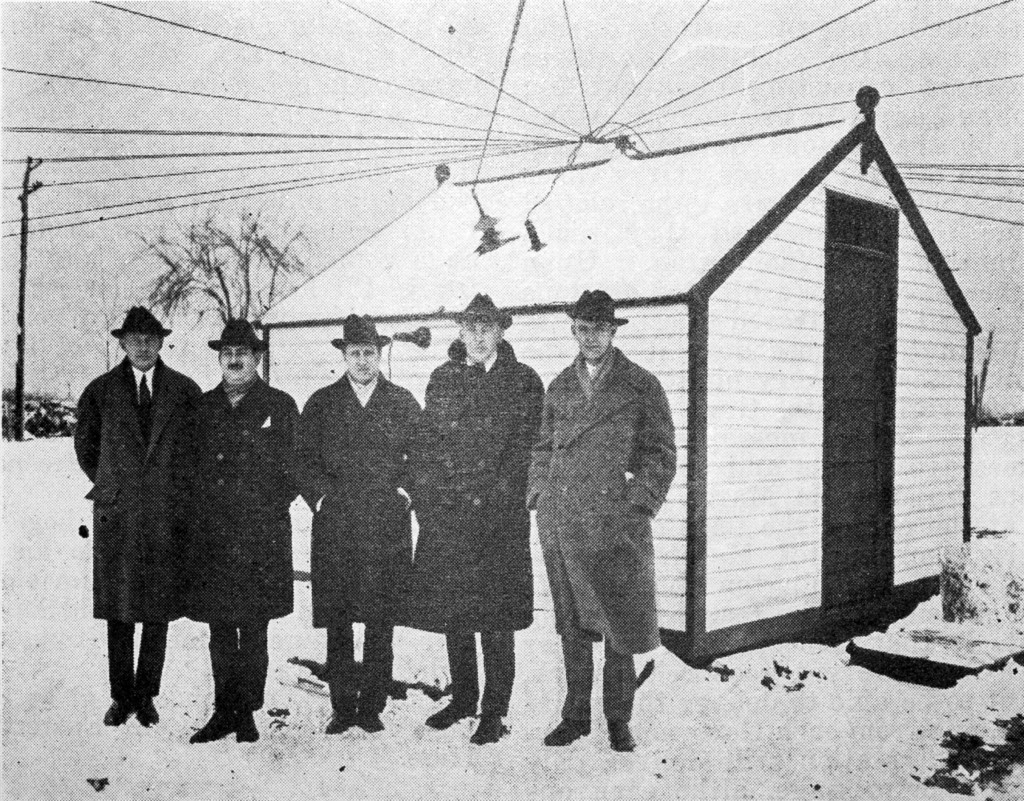
1BCG Designers, Builders, Operators: (L-R) Amy, Grinan, Burghard, Armstrong, Cronkhite
The transmitting station made famous by the test was the high brain-powered, as much as RF-powered, 1BCG. Having marveled at its consistently strong and steady signals, which were far better than any of the rest, Godley and Pearson had wondered what kind of transmitter and antenna the station was using.
Constructed especially for the transatlantic test, it was described at length, first by George E. Burghard at the R.C.A. meeting at Columbia on 20 December 1921, as Godley was on his return voyage, and reprinted in QST the following February.7
Because the identities of the qualifying transmitting stations had been kept secret, and since this new station was yet to be built when Godley left New York, he and Pearson had no way of knowing anything about it, other than who the call sign belonged to.
As Godley sailed for England, six R.C.A. members—Armstrong, Amy, Burghard, Cronkhite, Grunan and Inman—met on 18 November and decided to build a new station specifically to reach Godley. After considering several sites, they chose Cronkhite’s station, 1BCG, in Greenwich, Connecticut and began construction the next day. Working day and night, in snow and rain, they managed to finish the antenna and its extensive ground system on 30 November, and attempted their first transmissions late that night, with “expectedly poor results,” they reported.
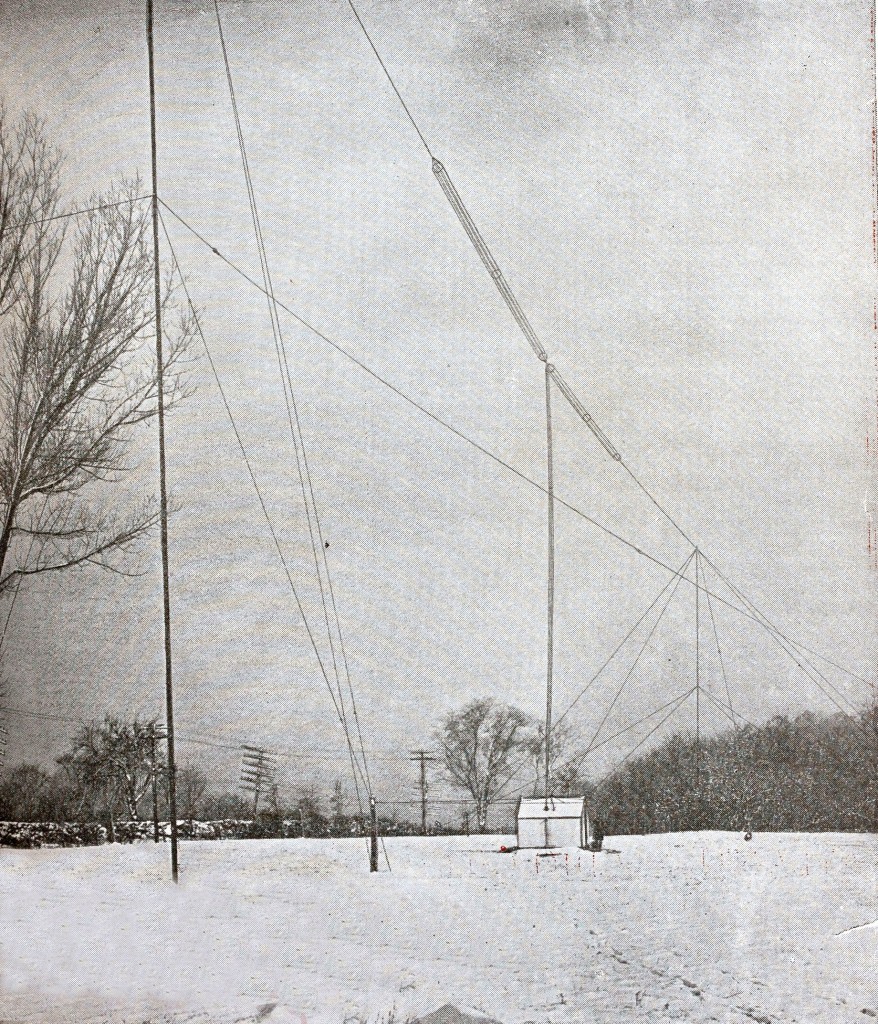
Antenna and Station at 1BCG
Supported by two masts, 108 and 75 feet tall and 230 feet apart, the transmitting antenna was a T-vertical, in which all three sections of the T were wire “cages.” It had a counterpoise radial system fanning out from the base of the feed line—there was no earth ground connection. The station being positioned at the center of it all permitted a very short lead-in connection to the transmitter. Antenna resistance measurements indicated that it was resonant near 190 meters. They were intending to work at 230 meters, which partly explained the poor first attempt.
A great deal of thought went into building a transmitter that would work optimally with the superheterodyne receiver Godley would be using. They wanted to be sure the frequency was stable so that he could make use of natural resonances of the headphones and his ears! Everything about the design was to be optimized, right down to the human element in the receiving system. Designing for a 1 kHz audio note in the receiver, they wanted as constant a radio frequency as possible in order to eliminate changes in audio that would be distracting to the receiving operator, or worse, make the signal inaudible. They would push the capabilities of the state of the art in 1921. But with people like Edwin Armstrong on the design team they were defining the state of the art.
“There is but one type of transmitter which can possibly meet this condition—the master-oscillator-amplifier type with a motor-generator for the plate supply,” they concluded, referring to a two-stage transmitter with a DC plate voltage produced by an AC motor driving a DC generator, instead of either a battery or a straight AC supply.
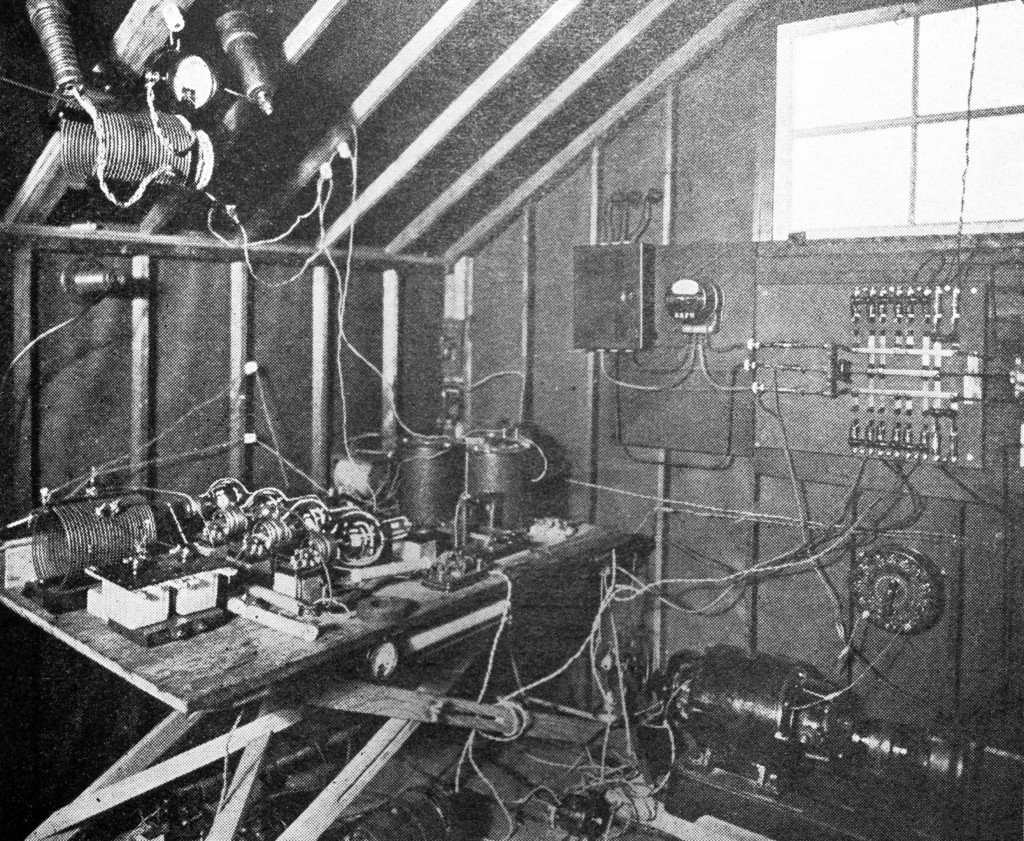
1BCG Station Equipment
The transmitter would have a UV204 Radiotron tube for the oscillator and three more in parallel for the final amplifier with 2200 DC volts on their plates. The oscillator would run continuously, to avoid frequency variations introduced by keying it on and off, and the transmitter was keyed by two relays8—one opened the grid-leak circuit disabling the amplifier stage, and the other shifted the wavelength of the oscillator by 5 meters (about 38 kHz)—in effect, FSK where the “back wave” or “back lash” component during key-up times was at greatly reduced power. The output circuit was coupled to the antenna through a fairly standard two-winding air transformer arrangement.
Methodically dealing with one problem after another over the course of several days, they finally had the new transmitter up and running just past 1:00 in the morning on 9 December, which explains why Godley did not hear them at all on the first night despite conditions being so good. They measured their antenna power as 558 watts (with 990 watts input power to the tubes).
By far, the most important innovation in this transmitter was the steadiness of its transmitted frequency, which did not vary under keying or with movement of the antenna, both of which affected most other CW stations of the time. “Observation on a windy night, when the notes of all C.W. stations heard were varying so badly as to be almost unreadable, showed the frequency [of 1BCG] to be absolutely unaffected by the motion of the antenna,” they noted.9
Several records were set by this station during the tests including distances of 3,800 miles to Amsterdam, 2,600 miles to California, and in message passing, a twelve-word one to Godley at Ardrossan, and three to Catalina Island, Calif.

Nearly coincident with the transatlantic tests, from 14 December to 5 January, Clifford J. Dow, 6ZAC, at Wailuku, Territory of Hawaii, had been receiving many mainland amateur stations, mostly special license stations, including a couple in the Midwest and an Army station, XF-1 at Langley Field in Virginia.10 Despite heavy QRN and harmonic QRM from NPM at Pearl Harbor, he also managed to copy message traffic directed to him “blind” by several West Coast stations. Dow had thus achieved something the transatlantics had not: the relaying of a routine message for a third party as part of normal ARRL relaying operations.
On the coast, 6ZR’s 1 kW spark on 375 meters in Los Angeles was the loudest arriving in Hawaii, beating even KPH, the RCA station in San Francisco; and 6ZAF, who was running 100 watts on CW was “in all over the house on two steps,” wrote Dow, referring to a detector with one or two steps of audio amplification making it audible far away from the headphones. Dow intended to build a set just like the one at 6ZAF to attempt a two-way contact.

In Europe, as reported by Coursey in The Wireless World, British amateurs had successfully received code groups from the scheduled stations and copied many other free-for-all stations.11 1BCG was heard by five different British amateurs. W. R. Burne, of Sale, Cheshire, heard seven stations and won the top British prizes. Coursey defended British amateurs against charges of inferior equipment being the reason for the failed earlier tests and lack of receptions prior to the December test.12 He attributed the success to the increased length of the tests, noting that the previous ones had run for only three days, and this time the major opening had only lasted that long. He also blamed it on the time zone difference and that British hams do not routinely stay up late (thus reinforcing their non-boiled-owl credentials). Furthermore, all the pre-war equipment in Britain had been confiscated by the government and, when returned, was mostly unfit for use, so they had to build from scratch after the war. Lastly, Godley was allowed to use a much longer antenna than is normally permitted for British amateurs.
Interest had also been high in France, where there had been some amusing confusion over Godley’s messages sent via MUU, which they copied every morning.13 He often used phonetic words instead of letters whenever he wanted to make sure a callsign or code group made it through, especially after the “MGES” mixup. So when he said he had heard “one able yacht,” the French took it to mean he heard a boat at sea. Dr. Pierre Carrot, editor of the French amateur magazine La T.S.F. Moderne wrote about their confusion:
Here is a puzzle for us! A correspondent writes us “I’ll be damned if I understand anything of this mystery where rams, dogs, foxes, yachts and even X-rays play such an important part ! ! ! might this not be a code?”
He proceeded to explain how phonetics could be used as code for letter groups, the way “the telephone girls” do it, he wrote. Once they figured out the “system” they had no further problem with Godley’s messages. But there were other words that caused confusion, such as beverage and sinkgap, which required explanation too.
French amateurs were being licensed for 100 watts of CW on 200 meters, partly resulting from the successful tests. Carrot went on to speculate about propagation effects, astonished that the short wavelengths “do carry” after all. Their scientists were at a loss to explain it, but suggested it might be due to reflection from “the higher strata of the atmosphere.” Could it have been related to the moon? Based on which days signals were and were not heard, perhaps moonlight had an effect, since it was well known that “short waves are particularly sensitive to the absorbing effects of light.” The full moon was on 15 December and Godley had heard nothing but “feeble signals” from the twelfth onward.

A sidebar to Godley’s QST article reported that F. Clifford Estey, 1AFV, had in January succeeded in passing three messages to W. W. Burnham in London who acknowledged them by cable.
As an early supporter of the test and prize sponsor, Burnham had heard of the American plan to send Godley over to listen. After reading how only the American hams were “dyed in the wool” and could stay up to all hours listening, he had embraced and upped Warner’s challenge and bet ARRL a new spring hat that Godley would not hear any American signals at all—never mind it becoming commonplace. July QST showed the ARRL secretary wearing his prize.14
The hat, which was made by Harrod’s, is handpainted in colors, bearing on one side the Union Jack and on the other the Stars and Stripes, united by wireless flashes which encircle the crown. Inside the hat is the inscription “From W. Witt Burnham, M.I.R.E., to Kenneth B. Warner, Secretary, A.R.R.L.”, while on the front in hand-painted lettering is ”In Commemoration of the Success of the Anglo-American Wireless Test organized by the A.R.R.L., 1921.”
It looks rather like some versions of the lid worn by the Mad Hatter in Lewis Carrol’s Alice’s Adventures in Wonderland.
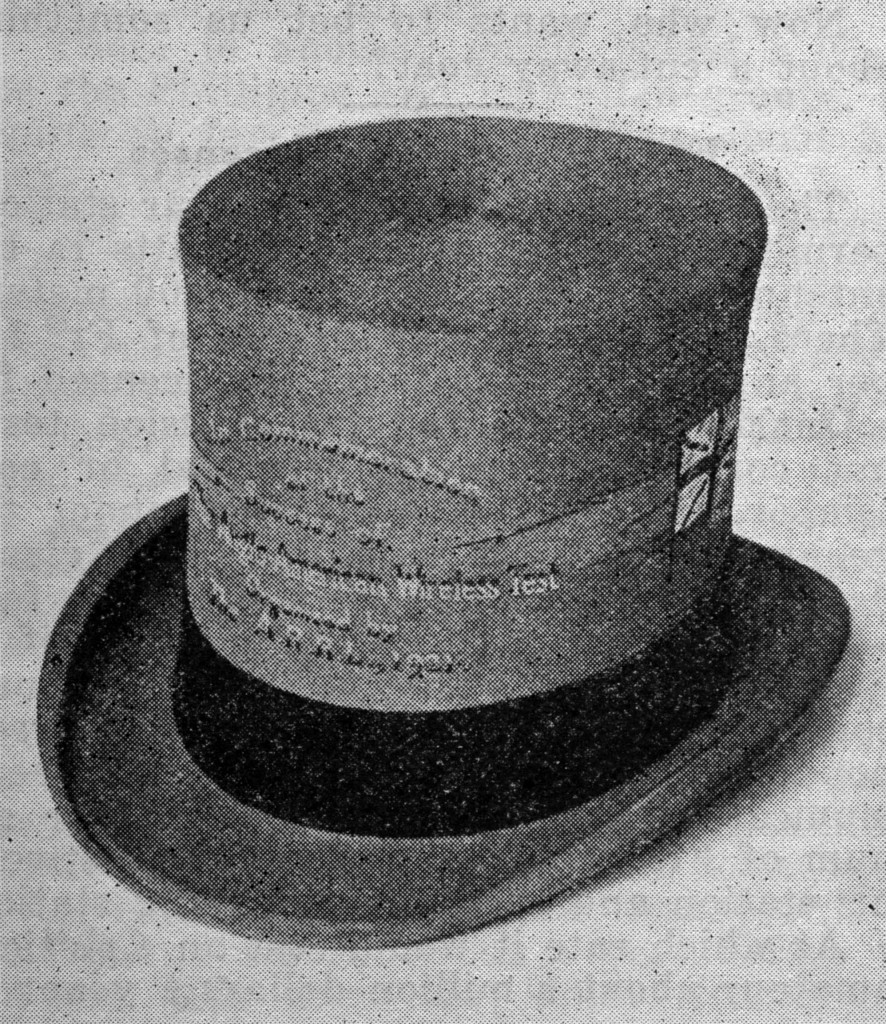
Burnham’s spring hat
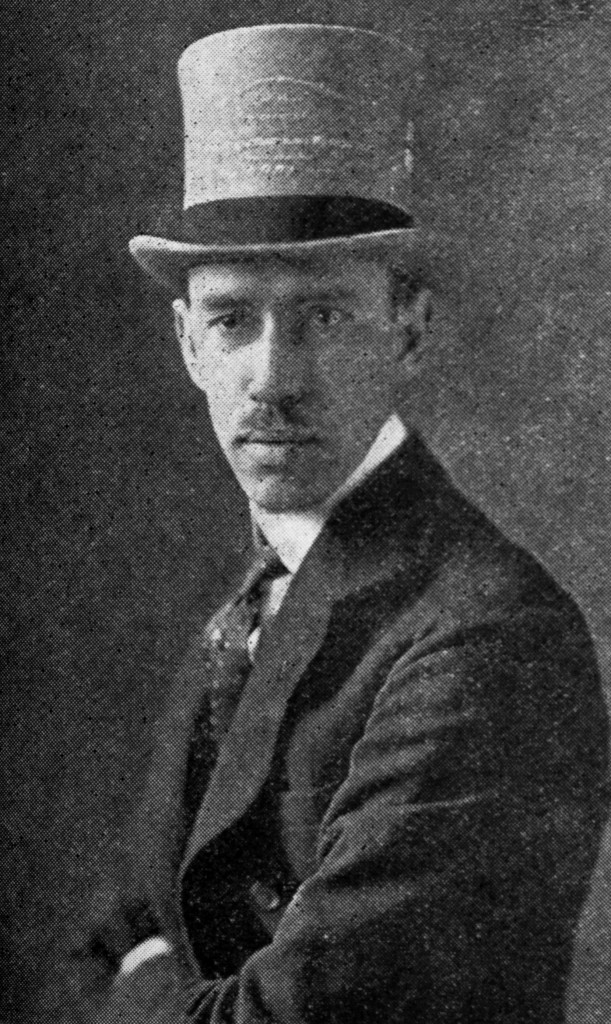
Kenneth Warner wearing his prize

de W2PA
- Phillip Coursey, the British test coordinator. ↩
- K. B. Warner, “Excelsior!,” Editorial, QST, January 1922, 25. ↩
- “Re: Our January Editorial,” Radio Communications by the Amateurs, QST, April 1922, 63. ↩
- “Amateur Radio’s Triumph,” The New York Times, December 18, 1921. ↩
- “Maxim is Pleased with Radio Tests,” The New York Times, December 18, 1921. ↩
- The Editor, “The Story of the Transatlantics,” QST, February 1922, 7. ↩
- G. E. Burghard, “Station 1BCG,” QST, February 1922, 29. ↩
- The relays were referred to as “mechanically-controlled keys.” ↩
- Interestingly, it was difficult for the team to get accurate reports from listeners about the steadiness and quality of their signal, because 1BCG’s signal was so strong that it would cause nearby receivers (within 50 miles) to shift frequency, having unstable oscillators themselves and lacking any sort of automatic gain control. Instead, they were able to fashion a local signal monitor that could develop a beat note using the third harmonic of the detector oscillator against the station’s primary signal. ↩
- “And Now, Transpacifics,” QST, March 1922, 7. ↩
- “The European Transatlantic Results”, QST, March 1922, 20. ↩
- Philip R. Coursey, “Report on Receptions by British Amateurs in the Transatlantic Tests, December, 1921,” QST, May 1922, 23. ↩
- “More About the Transatlantics,” QST, April 1922, 35. ↩
- “An Echo of the Transatlantic Tests,” International Amateur Radio, QST, July 1922, 35. ↩
